
The world of bike wonks is abuzz this morning as national nonprofit advocacy group People for Bikes has released their much-anticipated city ratings. And Portland fared quite well with a score of 3.3 out of 5 that puts us first among big cities and fourth overall. A total of 480 cities were part of the analysis.

(Photo: Roger Geller)
Among big cities, the ratings put Tucson, Arizona; Madison, Wisconsin; Washington D.C.; and San Diego, California in the top five along with Portland.
In addition to our good showing in the ratings, Portland was given a special award for having the highest “ridership score” of any city — a 3.9. According to People for Bikes, Portland earned a perfect score of 100 in this ridership metric, in large part because it takes distance into account. “Contrary to some local narratives,” they shared on Twitter this morning. “Portland is truly extraordinary in the amount of bike commuting that happens far from its core.”
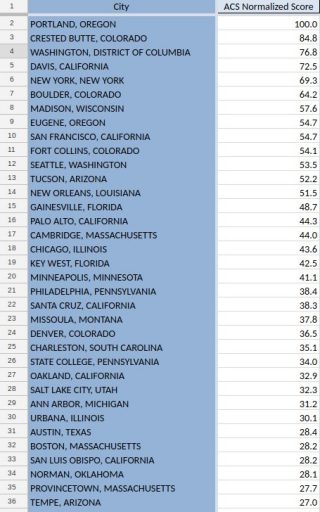
PFB Staff Writer Michael Andersen explained this further in a blog post about the ratings:
“Instead of comparing bike commuting rates the simplest possible way — the percentage of workers who live within city limits who report commuting mostly by bike on a random week — it introduces a much smarter way to weigh commuting rates against each other.
First, the method doesn’t penalize cities like New York or Boston for having lots of transit or foot commuting. Instead of measuring bike commuters as a share of all commuters, it compares bike commuters to the number of car commuters.
Second, the method doesn’t penalize cities like Indianapolis or Tucson for having far-flung city limits that happen to include suburban-style neighborhoods.
… But in the best bike cities, distance from the “biking core” matters less. We score cities not only by how much biking there is their core, but also how much biking there is one mile away, two miles away and so on. This removes city borders as a factor.”
These new ratings are unlike anything the bike advocacy world has seen before. In the past, the only rankings systems anyone paid much attention to were the Bicycle Friendly City designations (where we got “Platinum” in 2008) and statewide rankings from the League of American Bicyclists (where Oregon placed sixth in 2015), Bicycling Magazine’s “Best Bike City” issue (which lost all credibility when it took Portland’s #1 ranking away in 2010 just to sell more magazines), and, to a lesser extent, the “Bike Score” rankings from Walk Score.
People for Bikes’ (PFB) city ratings (a program funded by Trek Bicycles) look to be the most comprehensive and data-driven analysis yet. They are also the most transparent, which means anyone can delve deeper into the methodology and the raw numbers to find out how the sausage was made — and more importantly, what it would take to boost a rating.
The ratings were determined on a five-point scale across five major factors: Ridership, Safety, Network, Reach and Acceleration. Here’s how each of them is defined:
Advertisement
RIDERSHIP
The Ridership score reflects how many people in the community ride bikes. It considers biking for both recreational biking and biking for transportation. Data Sources: ACS, SMS, Community SurveySAFETY
The Safety score considers fatalities and injuries of people on bikes as well as those walking and driving. Perceptions of safety are also given weight. Data Sources: FARS, Community Survey, City SnapshotNETWORK
The Network score evaluates the quality of the bike network — how completely it connects people to each other and local destinations using comfortable routes. Perceptions of the network are also given weight. Data Sources: BNA, Community SurveyREACH
The Reach score determines how well a community’s low-stress network serves all members of the community. It uses demographic data to understand differences in access and connectivity for traditionally underserved populations compared to the whole city. Data Sources: ACS, BNAACCELERATION
The Acceleration score assesses how quickly a community is improving its biking infrastructure and how successful its encouragement programs are at getting people to ride. Data Sources: City Snapshot, Community Survey
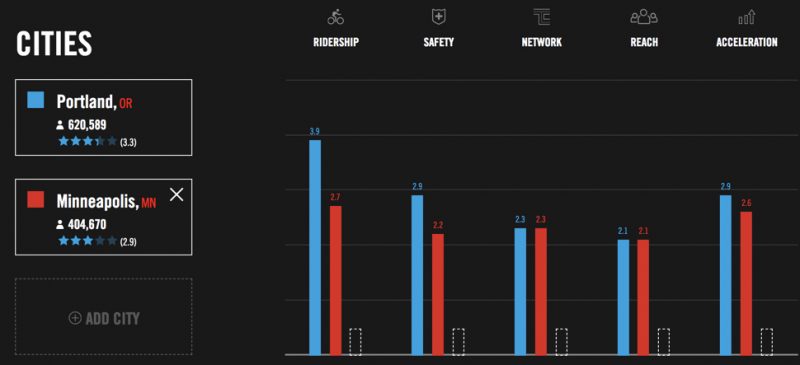
Since PFB’s core mission is to improve bicycling in America, the rating system is targeted at agency staff and planners who want a tangible metric to help make decisions and track progress (or lack thereof) year-over-year.
In addition to using existing datasets, PFB input qualitative insights gleaned from thousands of surveys filled out by riders from every city. A total of 187 data points per city went into the overall scores. PFB has a full-time data researcher (Jennifer Boldy, Ph.D, the former president of Breakaway Research Group) on staff who has worked on this project since being hired two years ago.
The ratings are complemented with a useful website where you can sort cities by all metrics (including population) and even choose three cities for head-to-head comparisons (yes we beat Minneapolis, thank you very much).
PFB unveiled the listings at their annual Places for Bikes conference which wraps up today in Indianapolis. Portland Bureau of Transportation Bicycle Planner Roger Geller was in Indianapolis this week to learn more about the ratings and accept our awards.
If you’re so inclined, I recommend taking a closer look at the methodology to learn more about the analysis that went into these ratings. PFB says they plan to crunch the numbers every year.
— Jonathan Maus: (503) 706-8804, @jonathan_maus on Twitter and jonathan@bikeportland.org
Never miss a story. Sign-up for the daily BP Headlines email.
BikePortland needs your support.



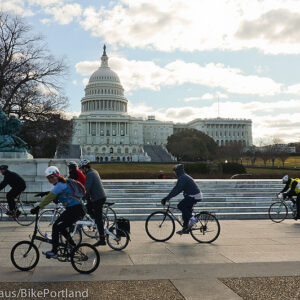
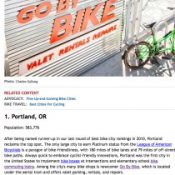
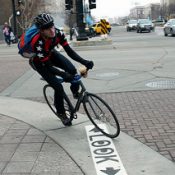
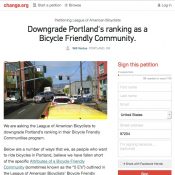
Thanks for reading.
BikePortland has served this community with independent community journalism since 2005. We rely on subscriptions from readers like you to survive. Your financial support is vital in keeping this valuable resource alive and well.
Please subscribe today to strengthen and expand our work.
I really hope this isn’t used to limit funding for the bicycle network in future years. It’s sad that this is the gut reaction but that seemed to be the impact the last time a major designation came Portland’s way. Maybe this time the awards will prompt a doubling-down of funding and focus on improving and connecting the network.
We can hope.
I think this list shows what diligently working on infrastructure and building bike communities can do. My hometown of Wausau, WI was on the list of worst places to ride a bicycle when I was growing up. Today it is No. 2 on this bike friendly list and No. 1 in small cities (in all fairness, Stevens Point 30 minutes to the south of us is not in their database but easily more bike friendly). Wausau has developed a bike/ped committee that is attended by city engineering staff and police, who actively pursue concerns/issues suggestions made at meetings by committee members and the public. At a difficult to cross intersection near my house, for example, someone brought it to the committee’s attention and city engineers experimented with a bike sensor they built into the pavement – now getting across is a breeze.
I think things such as this ranking are valuable, because they give kudos to the leaders who have helped make these changes possible and provide encouragement for them to continue. It gives them a feather in their cap that they can use to help sell their city. I hope this ranking has the same impact in Portland, looked to by the rest of us bicycle advocates in smaller communities who look to Portland as being at the forefront of American bicycling culture. Portland’s fun, non-competitive rides inspired my own founding of Bike Fun Wausau (via Poky Pedaling Stevens Point), which brought something new to my city. Visiting Portland last summer really made me fall in love with the city. Congrats Portland on your ranking and we’ll be watching you for inspiration!
This is what you get when you put Michael on the case!
Great design.
“Lost all credibility in 2010” – ha! The day the MPLS/PDX rivalry dies will be a sad one for biking. Thanks for the coverage, Jonathan. I think there are definitely problems with our system but I also think it’s introducing a bunch of good new ideas.
Strategically, I think one of the best parts of this is going to be that it balances the “new hotness” and “actually awesome city that’s done a lot of work already” factors pretty well. Cities are definitely going to move up and down each year. Ideally, the result should be that no city can rest on laurels, and almost any city can muscle its way to recognition by trying hard.
I agree with you on all counts. Not surprisingly, though, I disagree with Jonathan that Bicycling “lost all credibility” in 2010 by valuing momentum in their rankings. If anything, it’s Portland that deservedly lost a lot of credibility for the stagnation that we had run into … and from which Portland has still not fully recovered.
As for Portland “beating” Minneapolis: well yes its a solid win … but with some asterisks, and not by as much as it ought to be.
– Ridership is the most clear winning category for Portland. No surprise given the climate differences (though in the summer, Minneapolis’ ridership probably meets or beats Portland’s), and the overall more car-dependent, freeway-crazed culture here.
– Safety I’ll grant too, since drivers here are much more aggressive (though to be fair, they’re far less hostile to cyclists than in Portland, which helps offset stress levels).
– On Acceleration, I understand the rating is based on the results of three survey questions, but knowing both cities I cannot even remotely agree with Portland being ranked higher than Minneapolis. Yes Portland is finally building protected lanes, but Minneapolis is well ahead and still putting them in at a rapid rate. There have been a couple of high-profile “bike lane fights” here in the last year, a relatively new phenomenon, so maybe that’s put a damper on people’s enthusiasm? I will point out that cyclists won the more important of these two battles.
– Reach (availability of the network to disempowered communities) is equally low for both cities, and that makes sense given the timing of the survey. I will note that the survey probably does not some *major* protected lane projects completed late last year and planned for this year in impoverished North Minneapolis, wiping out much of the historical discrepancies in the quality of bike infrastructure there. I don’t see Portland making enough comparable progress in its under-served areas.
I’ll address Network in a separate post.
I have to take issue with the claim that the survey doesn’t penalize cities with far-flung boundaries that include lots of low-density postwar development. In any metropolitan area you’re going to have better infrastructure and higher ridership near the core, decreasing the further out you go. If your survey is based strictly on municipal boundaries you’re not getting apples-to-apples comparisons. I’m not saying there is an easy way to *do* apples-to-apples comparisons – I don’t think there is – but let’s not pretend it doesn’t affect the result.
If anything, this methodology actually hurts the Network (and Ridership) rankings for Portland, which includes large areas like the Southwest Hills and outer East that are decidedly unfriendly for biking, some of which didn’t even get annexed until the 1980s. In Portland the quality (and ridership level) of biking is high within a 3-5 mile core radius but quickly degrades as you move out, so where you draw the boundaries of your survey matters a lot.
No one should be surprised the next thing I’m going to do is contrast with Minneapolis: these two cities are opposite outliers in this regard, which highlights why it matters. Besides the fact that it’s only “half” of an unusual dual-municipality urban core, Minneapolis had its boundaries frozen by the legislature in 1925, putting nearly all development since that time into suburban municipalities. Biking quality in the center isn’t as good as Portland in the center – but doesn’t degrade as fast, as you move out.
So if you tried to do an apples-apples comparison by focusing the survey on parts of Portland comparable to Minneapolis’ boundaries (more or less those areas developed before WWII), Portland’s Network and Ridership rankings would be much higher than they are.
Conversely, if you tried to do the comparison drawing a line around development comparable to Portland’s city limits, to Minneapolis you’d have to add St. Paul and big chunks of 9 or 10 suburbs, a population of probably 950k or so. That would hurt the Ridership and Network rankings quite a bit, not least because St. Paul is not much better than the inner-ring suburbs for biking. Either way, Portland would easily beat Minneapolis in the Network ranking if you surveyed areas of comparable urbanization, though under the second methodology it wouldn’t be by as much.
On the other hand, if you were to move out from there to the suburbs, including either the entire metro areas or a specific suburban ring, the Twin Cities would come out ahead thanks to its vast network of MUPs extending across all three rings of suburbs, not even remotely matched in the Portland suburbs.
So methodology matters. In the scheme of things this doesn’t affect Portland’s #1 ranking, but for other cities further down the list it probably profoundly affects some of the rankings to compare cities that include vast suburban sprawl with others that are more urban within their boundaries.
It’s helpful to go through each index and check the “top ten” of each. My original home town of Grand Forks ND is #1 on Reach, as they have off-street bike paths in nearly every mile section of town and population is evenly distributed, but terrible on ridership and safety. The system had grown so steadily and slowly that it doesn’t even register on the Acceleration index. I must confess I have trouble believing that Greensboro NC, where I live now, and Portland are equally safe to ride in (both at 2.9)
Thanks for the effort, but I’m not sure if a lot of the non census data has much scientific validity. Comparing cities based on as few as 100 not random survey responses seems bogus.
Sorry, but it’s very hard to buy into this and be enthused. Many parts of this city are still a nightmare for cyclists. Sometimes to the point of it’s easier just to give up and drive.
If you dig into the detail of how they calculated ridership, it’s not what you’d expect. Portland only scored at the top because the ridership “target” number (7.8%) is less than the current bike mode share number (8.8%). They didn’t use the city’s 25 percent more share target in the calculation. If they had, Portland never would have scored so high. The devil is in the details. Other places, like Crested Butte, were assigned target numbers as high as 51%! Reach is also not clearly explained – it’s really just how easy it isn’t get to an off-street recreational bike path.
The language they use is a little misleading: The target ACS mode share number is where they take into account a city’s land area (see page 4 in the methodology PDF): Geographically small cities are assigned very high target mode share numbers; spread out cities have lower targets. I’m not sure I fully understand how they got to their formula. I think it comes down to taking specific land area chunks (2, 4, 8, 20, 30, 40, 60, 80, 100, 150, 200, 300), then taking the highest mode share performer in each of those categories, and then building a regression model. So the 7.8% target for Portland is calculated with their formula of 0.891*LandArea^(-0.47). But yes, the 5 points in the category boosted Portland a lot, as it should.
The question isn’t what a score is relative to others — the rankings are determined by the biases built into the measuring tools.
Rather, it is whether you can cycle where you want. Based on what I read here, people find it neither cyclable nor enjoyable. If that gets you a high ranking, the future of cycling is not bright.
They seem to have discarded all of the work that went into the BNA scores when they actually calculated the ratings. Those scores are the ones that indicate how well connected a community is for bicycling. The rest is just fluff and aspirational window dressing. http://bna.peopleforbikes.org
While I find the pace of constructing PBLs in NY slower than I would prefer and I disagree with many of De Blasio’s policies (the e-bike kerfuffle to name just one), the city has put in many more miles than any other in the country (ie 18.5 in 2016, 25 miles in 2017, and around 20 are planned for 2018). So it is confusing that people for bikes gave NYC a 1.9 out of 4 for “acceleration,” aaaaand Portland gets a 2.9? Huh?